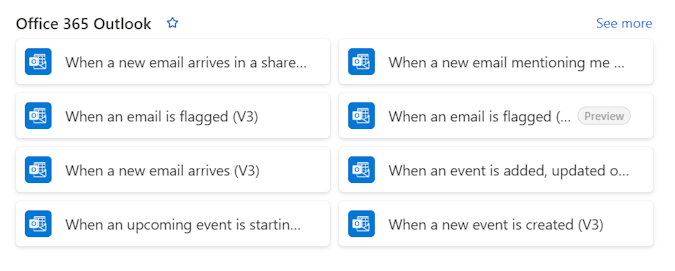Note
Access to this page requires authorization. You can try signing in or changing directories.
Access to this page requires authorization. You can try changing directories.
A trigger is an event that starts a cloud flow. For example, you want to get a notification in Microsoft Teams when someone sends you an email. In this case, receiving an email is the trigger that starts this flow.
Power Automate offers connectors to services such as SharePoint and Outlook. Most connectors offer prebuilt triggers that you can use to start your flows. Here's a partial look at the triggers that Office 365 Outlook connector provides by default.

Learn more about triggers in this quick video:
Choose the right trigger
Triggers can be started instantly or manually, on a schedule, or automatically when an external event occurs, such as when an email arrives. The following table lists some common trigger scenarios and the type of flow you should create.
| Trigger scenario | Flow type |
|---|---|
| Run a cloud flow with a tap of a button on your mobile device to remind your team to join the daily team meeting. You can trigger these flows manually from any device. | Instant/manual |
| Run a cloud flow on a schedule, for example, to send a weekly project report. Choose when (date and time) and frequency (monthly/daily/hourly, and more). Learn more in Run flows on a schedule. | Scheduled |
| Create a cloud flow that performs tasks automatically after an event occurs, for example, a cloud flow that notifies you by email when someone tweets with a keyword you specify. Learn more in Create a cloud flow from scratch. | Automated |
Licensing for premium connectors
You need a standalone Power Automate license to access all premium, on-premises, and custom connectors. For flows within an app built in Power Apps, you can use a Power Apps license. Microsoft 365 plan licenses let you use standard connectors but not premium connectors. Learn more in the Power Platform Licensing Guide.
To find your license:
- Sign in to Power Automate.
- Select My flows.
- Select a cloud flow.
- In the Details section, view the details under Plan.